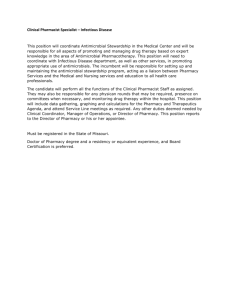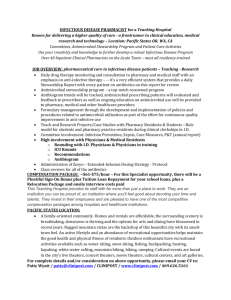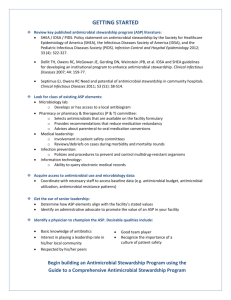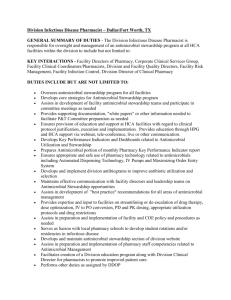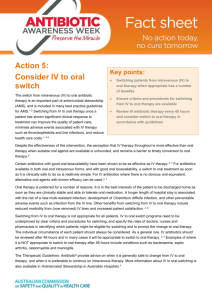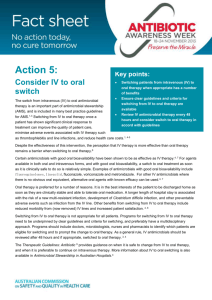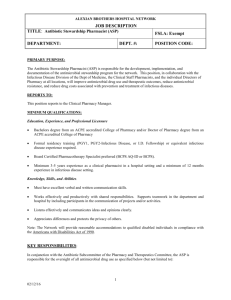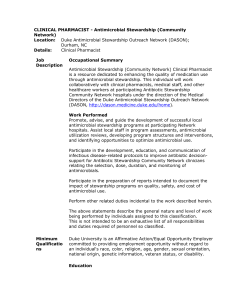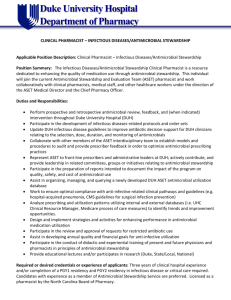Program - Western Australian Therapeutics Advisory Group
advertisement
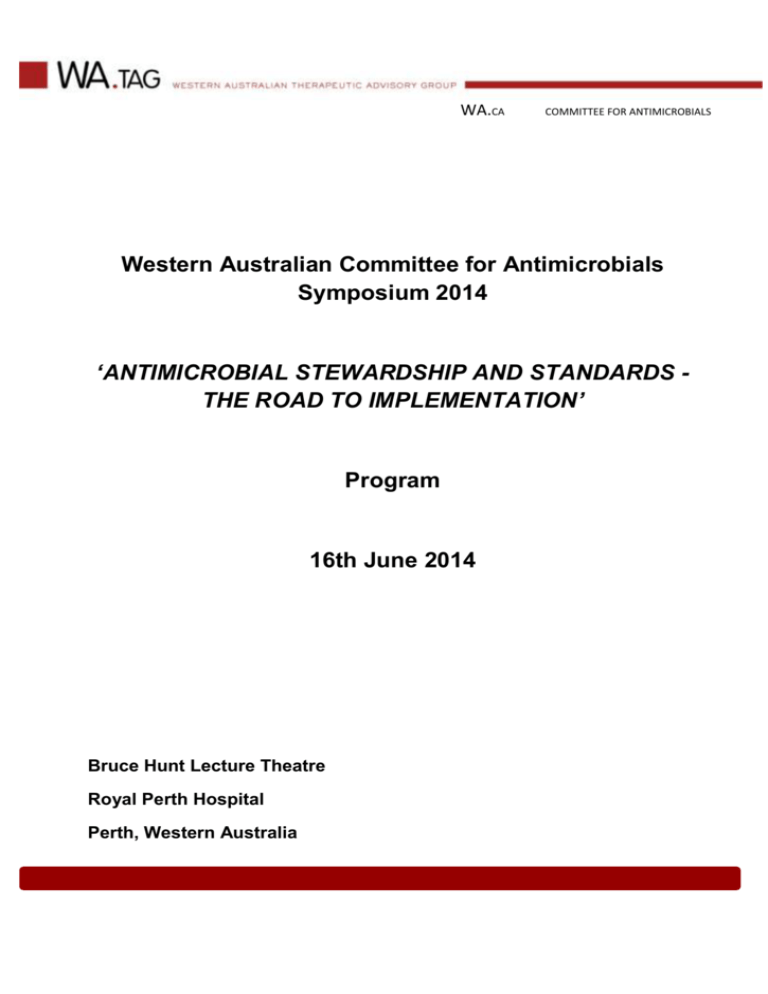
WA.CA COMMITTEE FOR ANTIMICROBIALS Western Australian Committee for Antimicrobials Symposium 2014 ‘ANTIMICROBIAL STEWARDSHIP AND STANDARDS THE ROAD TO IMPLEMENTATION’ Program 16th June 2014 Bruce Hunt Lecture Theatre Royal Perth Hospital Perth, Western Australia Welcome Page 1 of 22 Program 8:00 8:25 Registration Welcome Dr John Dyer Chair of WACA and Director Infectious Diseases Department, Fremantle Hospital and Health Service Professor Gary Geehoed, Chief Medical Officer, Department of Health, Western Australia. 8:30 "Resisting Antimicrobial Resistance (AMR) - Antimicrobial Stewardship in Australia." Debbie Carter, Australian Commission on Safety and Quality in Health Care. 8:55 “A Vitamin T Overdose? : An audit of piperacillin/ tazobactam use at Royal Perth Hospital.” Amelia Davis and Matthew Hanson (Abstract 1). Royal Perth Hospital 9:10 “What’s New in Hospital AMS?” Associate Professor Karin Thursky, Department of Infectious Diseases, Peter MacCallum Cancer Centre. 9:35 “Improving Antimicrobial documentation with the use of an Antimicrobial Plan sticker.” Evonne Fong, Armadale Health Service (Abstract 2). 9:50 “WACHS Antimicrobial stewardship.” Dr Helen Van Gessel, Western Australian Country Health Service-Great Southern. 10:15 Morning tea 10:45 "Antimicrobial Stewardship and the pharmacist." Matthew Rawlins Royal Perth Hospital. 11:15 ‘Tablet application central to hospital antimicrobial stewardship program.’ Chris Shenton, Joondalup Health Campus (Abstract 3). 11.30 “Super bugs, wonder drugs and flesh-eating furphies.” Tom Snelling and Jonathan Carapetis. 12:30 Lunch break 1:15 “Private hospitals and health funds – the challenge of AMS.” Dr Duncan McLellan, Western Diagnostic Pathology 1:45 “Implementation of a Hospital Paediatric Antimicrobial Stewardship Program.” Mona Mostaghim AMS pharmacist at Sydney Children’s Hospital, Randwick and Tom Snelling, Sydney Children’s Hospital (Abstract 4). “Antimicrobial stewardship in the community.” Shirley Harrison, NPS MedicineWise “These children get sicker, quicker.” Dr David Gaskell, Western Australian Country Health Service –Kimberley (Abstract 5). “Development of Antimicrobial Stewardship at Swan Districts Hospital- A work in progress.” Dr Marilyn Hassell, PathWest. “Antimicrobial stewardship in a mental health setting.” Sandra Mazarakis, The Marian Centre (Abstract 6). Closing remarks 2:00 2:25 2:40 3:05 3:20 Neil Keen, Chief Pharmacist, Department of Health, Western Australia. 3:30 Close Page 2 of 22 Western Australian Committee for Antimicrobials Dr John Dyer (Chairman) Director, Infectious Disease Department Fremantle Hospital and Health Service Dr Duncan McLellan Dr Ronan Murray Clinical Microbiologist and Infectious Disease Physician PathWest Head of Department of Microbiology Microbiologist and Infectious Disease Physician Western Diagnostic Pathology Dr Helen Van Gessel Dr Tom Snelling Director of Medical Services Infectious Disease Physician Western Australian Country Health ServicesSouth West. Princess Margaret Hospital Dr Michelle Porter Dr Owen Robinson Microbiologist and Infectious Disease Physician Infectious Disease Consultant Princess Margaret Hospital Royal Perth Hospital Matt Rawlins Dr Paul Ingram Infectious Disease Pharmacist Microbiologist and Infectious diseases Physician Royal Perth Hospital Royal Perth Hospital Anna Allman Rebecca McCann Senior Pharmacist Program Manager Fremantle Hospital and Health Service Healthcare Associated Infection Unit Public Health Division Kerry Fitzsimons Medication Safety Pharmacist, Fremantle Hospital and Health Service Pharmacy Advisor Quality Improvement and Change Management Unit, Dept of Health. Kathy Irwin Project Coordinator Western Australian Committee for Antimicrobials Page 3 of 22 Invited speakers Debbie Carter Australian Commission on Safety and Quality in Health Care Debbie leads the antimicrobial stewardship program at the Australian Commission on Safety and Quality in Health Care. Prior to this Debbie worked as a Team Leader at NPS MedicineWise, where she was involved in the development and implementation of behavioural change activities for health professionals and consumers as part of NPS’s national educational visiting programs. She has a pharmacist by background with over 12 years clinical experience specialising in haematology, bone marrow transplantation, and palliative care. Matthew Rawlins Infectious Disease Pharmacist, Royal Perth Hospital Matt is a Curtin University pharmacy graduate. He was the first antibiotic pharmacist at St Mary's Hospital London, UK and has been the infectious diseases pharmacist at RPH since 2004. He has been a key member of their long-running antimicrobial stewardship program since its inception. Helen Van Gessel Western Australian Country Health Service-Great Southern. Helen has been the director of medical services for the Great Southern region, WA Country Health Service since 2011. Prior to that she worked in Perth as an infectious diseases physician at RPH, was the inaugural chair of the RPH antimicrobial stewardship committee, a clinical advisor to the WA Office of Safety and Quality in Health care and a member of the Australian Commission on Quality and Safety HAI advisory group. Associate Professor Karin Thursky Department of Infectious Diseases Associate Professor Karin Thursky is an infectious diseases physician with appointments at Royal Melbourne Hospital and Peter MacCallum Cancer Centre and is an honorary fellow with the University of Melbourne medical school. She is actively involved in the area of quality and safety and has a national profile in antimicrobial stewardship, and development and implementation of consensus guidelines for the prevention and treatment of infections in the cancer patient. Her research area is broad with interests such as clinical epidemiology of infections in the immunocompromised host, health economics, and computerised decision support for stewardship, natural language processing and surveillance. Page 4 of 22 Dr Duncan McLellan Head of Department of Microbiology at Western Diagnostic Pathology Duncan is a consulting infectious diseases physician at Fremantle Hospital, St John of God Murdoch, Mount Hospital and Joondalup Health Campus. Shirley Harrison NPS MedicineWise educational visiting pharmacist Shirley graduated from the Victorian College of Pharmacy, is a Fellow of the Australian College of Pharmacy Practice and is a previous community pharmacy proprietor. She has experience in hospital pharmacy, research in hospital ward pharmacy, community pharmacy and is currently an HMR accredited pharmacist and NPS Educational Visiting Pharmacist. Marilyn Hassell PathWest. Marilyn completed her medical degree at UWA in 1994 and underwent advanced physician training in infectious diseases in Perth, Cairns and Darwin, a significant proportion of which involved management of patients in and from remote communities. She previously worked as an infectious diseases physician at Royal Perth and SCGH, and has a particular interest in home IV antibiotic therapy. She has been involved in antimicrobial stewardship at Swan Districts Hospital since 2010. Page 5 of 22 08:30 "Resisting Antimicrobial Resistance (AMR) - Antimicrobial Stewardship in Australia" Presenter Debbie Carter, Australian Commission on Safety and Quality in Health Care Page 6 of 22 8:55 A Vitamin T Overdose? : An audit of piperacillin/ tazobactam use at Royal Perth Hospital’ Authors M. Hanson, A. Davis, S. Benson, O. Robinson and M. Rawlins. Presenters Amelia Davis and Matthew Hanson. A cross sectional study was undertaken on 571 inpatients at Royal Perth Hospital to quantify and analyze the use of piperacillin/ tazobactam. Of the 571 inpatients, 256 were prescribed antimicrobials and, of these, 79 (30.86%) were prescribed piperacillin/ tazobactam. Inpatient progress notes and Antimicrobial Prescribing Survey (2013) data, were reviewed to establish the clinical scenario leading to the prescription of piperacillin/ tazobactam. Prescriptions were reviewed on a case-by-case basis and were deemed concurrent with guidelines, if piperacillin/ tazobactam was recommended by the Antibiotic Therapeutic Guidelines. In cases where the prescription was not concurrent with guidelines, two infectious disease physicians undertook further review to assess the appropriateness of the prescription. Of those prescribed piperacillin/ tazobactam, 39 (49.4%) of prescriptions were deemed not concurrent with guidelines, and 5.1% were prescribed at an incorrect dose or frequency. Diagnoses most associated with non-concurrent prescriptions were: community acquired pneumonia, sepsis, urinary tract infection, post- surgical prophylaxis and abscess. An in depth analysis may be required to highlight hospital-specific causative factors responsible for the “over prescription” of piperacillin/ tazobactam in order to guide future intervention and improve prescribing habits. Page 7 of 22 9:10 What’s New in Hospital AMS Presenter Associate Professor Karin Thursky, Department of Infectious Diseases, Peter MacCallum Cancer Centre. Page 8 of 22 Page 9 of 22 9:35 “Improving Antimicrobial documentation with the use of an Antimicrobial Plan sticker” Author E. Fong. Presenter Evonne Fong, Armadale Health Service. Objective or Purpose: The Australian Commission on Safety and Quality in Health Care has drafted a Clinical Care Standard for antimicrobial stewardship. This standard includes a number of quality statements describing the clinical care a patient should be offered for a specific clinical condition. Quality Statement 6 in this standard centres on documentation, and recommends that when a patient is prescribed antibiotics, the clinical reason, drug name, dose, route of administration, intended duration and review plan is documented in their medical record. The aim of this project was to improve documentation of antibiotic treatment and effective communication between clinicians. Health Services should ensure there is a system in place to support this documentation. Methodology: A baseline audit in November 2013 took a one day “snap shot” of inpatients prescribed antimicrobials. On the day of the audit, 57 inpatients were prescribed antimicrobials, with 85 current antimicrobial orders. The percentage of total antimicrobial prescriptions where an indication was documented was 67.1%. For best practice, this should ideally be greater than 95%. To improve documentation, AHS is piloting the use of a sticker in ICU, for inclusion in a patient’s integrated progress notes when an antimicrobial is newly charted (see Figure 1). Figure 1. Antimicrobial Plan Medical staff have been educated about using this sticker for documentation, which is to be launched in May. Results and reauditing are planned for June. Implications and relevance to other services: Compliance with using this sticker means that patients will have the details of their antibiotic treatment documented in their medical record. It also helps to ensure good communication between clinicians and complies with Quality Statement 6 in the Commission’s Clinical Care Standards as well as NSQHS standard 3 and standard 4 for accreditation. Biography Evonne is a clinical pharmacist working at Armadale Health Service in the Emergency Department and Intensive Care Unit Page 10 of 22 More note space available at end of booklet 9:50 WACHS Antimicrobial stewardship Presenter Dr Helen Van Gessel, Western Australian Country Health Service-Great Southern. 10:45 "Antimicrobial Stewardship and the pharmacist" Presenter Matthew Rawlins, Royal Perth Hospital. Page 11 of 22 11:15 Tablet Application Central to Hospital Antimicrobial Stewardship Program Authors Giannasi S and Shenton C. Presenters Chris Shenton and Sarah Giannasi, Joondalup Health Campus. Background: Joondalup Health Campus is a private/ public hospital of 650 beds in Perth’s northern suburbs. Joondalup Health Campus has grown quickly from 60 beds in 1995 to the current size. The emergency department is one of Perth’s busiest, with over 90,000 patients treated per year. This paper describes the setup of an AMS service and the central tablet based IT infrastructure that connects the team and collates the data. Methods: All clinical pharmacists at JHC have a role in the AMS program. AMS is an integral part of every pharmacist’s clinical round. The pharmacy IT team have developed an extension to the clinical pharmacy application, Clinical Workhorse, to manage AMS. The tablet displays data such as pathology, medication history and ward movements. One pharmacist collates the data and shares with the ID physicians. Results: The clinical pharmacists notate individual patient profiles with drug choice and indication. The ID physician will then review and provide advice on therapy. Ward pharmacists then review and record prescriber compliance and patient outcomes. Conclusions: This method of implementation involves all pharmacists in the AMS program. The outcomes of patients are recorded live and shared amongst all members of the team. Patients benefit from a widespread application of the AMS principles and pharmacists benefit from the growing knowledge of antimicrobials. Page 12 of 22 11:30 “Super bugs, wonder drugs and flesh-eating furphies” Presenters Tom Snelling and Jonathan Carapetis. 1:15 Private hospitals and health funds – the challenge of AMS Presenter Dr Duncan McLellan, Page 13 of 22 1:45 Implementation of a Hospital Paediatric Antimicrobial Stewardship Program Authors M.Mostaghim, T.Snelling, B. McMullan & P.Palasanthiran. Presenters Mona Mostaghim or Tom Snelling. Background: Antimicrobial Stewardship (AMS) programs based on Therapeutic Guidelines® recommendations are established in many adult hospitals and have been included in the National Safety and Quality Health Service (NSQHS) Standards. Implementing AMS programs in paediatric hospitals is complicated by limited evidence-based or consensus paediatric guidelines and frequent “off label” prescribing, particularly in complex settings such as transplantation and chemotherapy. With half of paediatric inpatients on average prescribed antibiotics AMS resources are required at the point of care to ensure timely access to antimicrobials. Aims: 1. Optimise antimicrobial use within a tertiary paediatric hospital by implementing an AMS program aided by an electronic approval and decision support system. 2. Achieve accreditation under NSQHS criteria 3.14 Antimicrobial Stewardship. Methods: Comprehensive review of best practice guidelines and literature on antimicrobial use in paediatric medical, surgical and high-risk patients, stratification of antimicrobials based on risk and site specific resistance data was undertaken and a multisite, multidisciplinary working party was formed. An electronic approval and decision support system was programmed comprising evidence- and consensus derived recommendations on optimal antimicrobial use, indication specific dose, route, duration, management and monitoring requirements. Guidance on IV to oral switch, escalation and de-escalation of therapy and access to endorsed guidelines were integrated into the approval process. Governance and evaluation structures are based on systematic collation of real-time and long term feedback, and auditing addressing cost, safety, quality, prescribing practices, system adherence and uptake of AMS team recommendations. Results: Biannual hospital-wide point prevalence audits identified 10% and 22% improvements in appropriate antimicrobial prescribing (6 and 12 months respectively) after implementation, with a trend towards reduced third generation cephalosporin, gentamicin and carbapenem use. NSQHS accreditation was achieved with merit for all elements of criteria 3.14. Conclusion: A comprehensive multidisciplinary paediatric AMS program was successfully implemented, performing routine evaluation and optimisation of antimicrobial use. Biography Mona Mostaghim is the Quality Use of Medicine, Medication Safety and Antimicrobial Stewardship pharmacist at Sydney Children’s Hospital Randwick, one of three tertiary centres for child health in New South Wales. Page 14 of 22 More note space available at end of booklet 2:00 Antimicrobial Stewardship in the Community Presenter Shirley Harrison, NPS MedicineWise. Page 15 of 22 Page 16 of 22 2:25 “These children get sicker, quicker”: Using AMS governance to develop consensus for assessment and early management of the unwell Aboriginal child in the Kimberley (Abstract 5) Authors Anti-Microbial Stewardship Committee ,Febrile Child Protocol Working Group. Presenter Dr David Gaskell , Western Australian Country Health Service – Kimberley. AntiMicrobial Stewardship Committee Febrile Child Protocol Working Group – WACHS – Kimberley In November 2011, a WACHS-K Febrile Child Protocol was produced to reduce mortality and morbidity from bacterial sepsis among Aboriginal children in the Kimberley. Unpublished clinical audit data corroborated subsequent positive impact across the region. When the WACHS-K Antimicrobial Stewardship (AMS) Committee convened in late 2013, one of its priorities was to collaborate with clinicians from diverse organisations to review this Protocol. Factors prompting this review included a need to better target the clinical content of the Protocol, feedback about its length and limited accessibility to clinicians outside WACHS-K and changing patterns of antibiotic resistance in the Kimberley. As Aboriginal babies and children in the Kimberley get ‘sicker, quicker’, it was important to focus on community-based management in very remote settings. The AMS Committee established a Working Group with representatives of key stakeholder services in the Kimberley which obtained inputs from a broad disciplinary range including primary health care, paediatrics, nursing and microbiology. Recognition of the diversity of service providers in the Kimberley has seen the creation of a common ‘Kimberley template’ which ensures that guidelines can be endorsed through the Kimberley Aboriginal Health Planning Forum (KAHPF) upon recommendation by an expert Standing Committee for universal use in the region. Using this common ‘Kimberley template’, the Working Group finalized a two-page flowchart in February 2014 for clinicians dealing with septic presentations due to infections of unknown origin in Aboriginal infants and children. This presentation will cover key revisions to the Protocol and their rationale including triage and risk assessment, advice for clinical decision-making and antibiotic choices. AMS achieved consensus across Kimberley service providers. Implementation of the final version of Assessment and Early Management of the Unwell Child will also be discussed. Biography Dr David Gaskell joined WACHS-Kimberley as Regional Medical Director in 2013 and brings diverse experiences in health systems design and delivery in both developed and developing countries. He is a member of the Regional Executive Team and maintains an active clinical role in general practice in Broome where he is currently based. As Chair, David has reinvigorated the Anti-Microbial Stewardship Committee by ensuring a wide disciplinary mix and an agenda responsive to the challenges of the Kimberley. Page 17 of 22 More note space available at end of booklet 2:40 ‘Development of Antimicrobial Stewardship at Swan Districts Hospital- A work in progress’ Presenter Dr Marilyn Hassell, PathWest. Page 18 of 22 3:05 Antimicrobial Stewardship in a mental health setting Author Sandra Mazarakis. Presenter Sandra Mazarakis, Accreditation Coordinator, The Marian Centre. Objectives: Identification of gaps and requirements in meeting Antimicrobial Stewardship criterion 3.14 of National Standard 3: Preventing and Controlling Healthcare Associated Infections. Implementation of effective and robust Antimicrobial Stewardship Team and governance structure for monitoring, development of formularies for use by practitioners, educating and facilitating correct antimicrobial prescribing as would be applicable to a mental health setting with more common infection presentations seen at our service. Methodology: Data collected for an annual period September 2012 – September 2013 to obtain a baseline of more common infections seen at our hospital. Antimicrobials prescribed to patients over reported period obtained from pharmacy supplying antimicrobials to the hospitals. Data collected retrospectively as a baseline for organisation to determine infection rates, community and healthcare associated infections. Data correlated with report from pharmacy on antimicrobials prescribed. Point prevalence study undertaken and results reported. Conclusion: Identification of requirement for imprest system of three common antimicrobials to treat common presentations noted at our hospital. Development of a formulary system for ease of reference for our Accredited Psychiatrists and Clinical Staff. Plan to perfect our current process over next 12 months and then focus on identification of more common infection patient presentations and focus on targeted point prevalence studies specific to more common presentations. Biography Sandra Mazarakis is an accreditation coordinator and registered nurse. She has worked in a variety of clinical settings since 1991 – acute, general, transplant, aged care, telephone triage, quality and risk management and accreditation. She is currently working in mental health setting with a role that involves accreditation. Page 19 of 22 Notes Page 20 of 22 Notes Page 21 of 22 Page 22 of 22 Notes Page 23 of 22 Notes Page 24 of 22 Page 25 of 22
